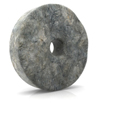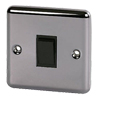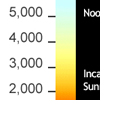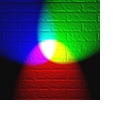
Ten Good Reasons To Switch
 Long Life
Long Life
LED bulbs have a far longer lifetime compared to conventional light bulbs. They can last up to 50,000 hours with very small reductions in light output over their lifetime. Replacing them is often not needed. Compare that to 15,000 hours for a compact fluorescent lamp (CFL) bulb and just 1,000 hours for an standard incandescent bulb. To put into perspective - if used every day for 8 hours a day, an LED bulb can last over 15 years.

 Energy Efficient
Energy Efficient
LED bulbs are very energy efficient. They consume 80-90% less power than standard incandescent light bulbs. LED bulbs also retain 98% of their brightness for the first 1,000 hrs of use.

 Highly Durable
Highly Durable
LEDs are not affected by shaking or vibration. They have an exceptionally low failure rate and maintenance is virtually eliminated. LED lighting are solid-state and do not have a filament and so are highly durable.

 Lower Carbon Footprint
Lower Carbon Footprint
According to the Energy Information Administration of U.S. Department of Energy, A single kilowatt-hour of electricity will generate 1.34 pounds (610 g) of CO2 emissions. Assuming the average light bulb is switched on for 10 hours a day, a single 40w incandescent bulb will generate 196 pounds (89 kg) of CO2 every year while an LED bulb generates only 63 pounds (29 kg) over the same duration. By exchanging all incandescent bulbs for new LEDs, a building’s carbon footprint from lighting can be reduced by 68%

 No Mercury
No Mercury
LED bulbs are recyclable and much easier to do so because they don't contain mercury or other harmful pollutants. CFL bulbs contain mercury and if broken there are immediate health and environmental risks. Mercury is highly toxic and can be inhaled and absorbed through the skin and mucous membranes. Specific cleaning procedures must be used to avoid exposure. Proper disposal requires special handling and transportation to a qualified disposal facility.

 No UV Radiation
No UV Radiation
LED bulbs are lit through a process which involves electrical current flowing to semiconductors. Unlike incandescent and CFL bulbs, LED bulbs do not require a filament or gasses which use heat as the source of light. LED bulbs produce no harmful UV radiation. This makes them perfect for museums and galleries to light precious artefacts or paintings.

 Less Heat
Less Heat
LED bulbs produce much less heat than conventional lights where 90% of the energy is converted to wasted heat. While there is a slight amount of heat generated, it is not in the infrared or ultraviolet portions of the light spectrum. With efficient heat sinks LED lights operate at less than 60°C, and are cool to the touch. So no more burnt fingers. An important additional benefit of low heat production is less need for air-conditioning to create a cooler environment in enclosed spaces such as offices and shops.

 Switch On-and-Off-able
Switch On-and-Off-able
Constant switching on and off can drastically reduce the lifetime of standard light bulbs and CFLs. Standard CFL bulbs installed in locations where frequent switching is likely e.g. in toilets or corridors with motion sensors will not reach the full lifetime expected of the bulb. The more robust design and properties of LED bulbs mean they do not suffer from lowered life expectancy due to frequent switching. LED bulbs also turn on to full brightness instantly ('instant on'), unlike CFLs which take time to reach full brightness.

 Colour Temperature
Colour Temperature
Incandescent bulbs always provide the same 'warm white' colour (2700-3000K), LED bulbs offer a wider range of colour temperatures. 'Warm white' helps create a warm relaxing mood. 'Natural white' is well suited for environments where accurate colour reproduction is critical. 'True white' or 'blue white' reproduces blue sky daylight colour. Studies show that a more natural 'daylight' white light is conducive to higher attention and concentration levels

 Total Colour Control
Total Colour Control
LEDs are semi-conductors, so unlike the other light sources LED functions can be controlled with a microprocessor to achieve unique lighting effects. This is achieved by switching the light output of the RGBW channels of LEDs. By varying the output of each of the LED channels it allows the user to choose from millions of colours in order to create countless lighting effects and moods.

 Long Life
Long LifeLED bulbs have a far longer lifetime compared to conventional light bulbs. They can last up to 50,000 hours with very small reductions in light output over their lifetime. Replacing them is often not needed. Compare that to 15,000 hours for a compact fluorescent lamp (CFL) bulb and just 1,000 hours for an standard incandescent bulb. To put into perspective - if used every day for 8 hours a day, an LED bulb can last over 15 years.
 Energy Efficient
Energy EfficientLED bulbs are very energy efficient. They consume 80-90% less power than standard incandescent light bulbs. LED bulbs also retain 98% of their brightness for the first 1,000 hrs of use.
 Highly Durable
Highly DurableLEDs are not affected by shaking or vibration. They have an exceptionally low failure rate and maintenance is virtually eliminated. LED lighting are solid-state and do not have a filament and so are highly durable.
 Lower Carbon Footprint
Lower Carbon FootprintAccording to the Energy Information Administration of U.S. Department of Energy, A single kilowatt-hour of electricity will generate 1.34 pounds (610 g) of CO2 emissions. Assuming the average light bulb is switched on for 10 hours a day, a single 40w incandescent bulb will generate 196 pounds (89 kg) of CO2 every year while an LED bulb generates only 63 pounds (29 kg) over the same duration. By exchanging all incandescent bulbs for new LEDs, a building’s carbon footprint from lighting can be reduced by 68%
 No Mercury
No MercuryLED bulbs are recyclable and much easier to do so because they don't contain mercury or other harmful pollutants. CFL bulbs contain mercury and if broken there are immediate health and environmental risks. Mercury is highly toxic and can be inhaled and absorbed through the skin and mucous membranes. Specific cleaning procedures must be used to avoid exposure. Proper disposal requires special handling and transportation to a qualified disposal facility.
 No UV Radiation
No UV RadiationLED bulbs are lit through a process which involves electrical current flowing to semiconductors. Unlike incandescent and CFL bulbs, LED bulbs do not require a filament or gasses which use heat as the source of light. LED bulbs produce no harmful UV radiation. This makes them perfect for museums and galleries to light precious artefacts or paintings.
 Less Heat
Less HeatLED bulbs produce much less heat than conventional lights where 90% of the energy is converted to wasted heat. While there is a slight amount of heat generated, it is not in the infrared or ultraviolet portions of the light spectrum. With efficient heat sinks LED lights operate at less than 60°C, and are cool to the touch. So no more burnt fingers. An important additional benefit of low heat production is less need for air-conditioning to create a cooler environment in enclosed spaces such as offices and shops.
 Switch On-and-Off-able
Switch On-and-Off-ableConstant switching on and off can drastically reduce the lifetime of standard light bulbs and CFLs. Standard CFL bulbs installed in locations where frequent switching is likely e.g. in toilets or corridors with motion sensors will not reach the full lifetime expected of the bulb. The more robust design and properties of LED bulbs mean they do not suffer from lowered life expectancy due to frequent switching. LED bulbs also turn on to full brightness instantly ('instant on'), unlike CFLs which take time to reach full brightness.
 Colour Temperature
Colour TemperatureIncandescent bulbs always provide the same 'warm white' colour (2700-3000K), LED bulbs offer a wider range of colour temperatures. 'Warm white' helps create a warm relaxing mood. 'Natural white' is well suited for environments where accurate colour reproduction is critical. 'True white' or 'blue white' reproduces blue sky daylight colour. Studies show that a more natural 'daylight' white light is conducive to higher attention and concentration levels
 Total Colour Control
Total Colour ControlLEDs are semi-conductors, so unlike the other light sources LED functions can be controlled with a microprocessor to achieve unique lighting effects. This is achieved by switching the light output of the RGBW channels of LEDs. By varying the output of each of the LED channels it allows the user to choose from millions of colours in order to create countless lighting effects and moods.

